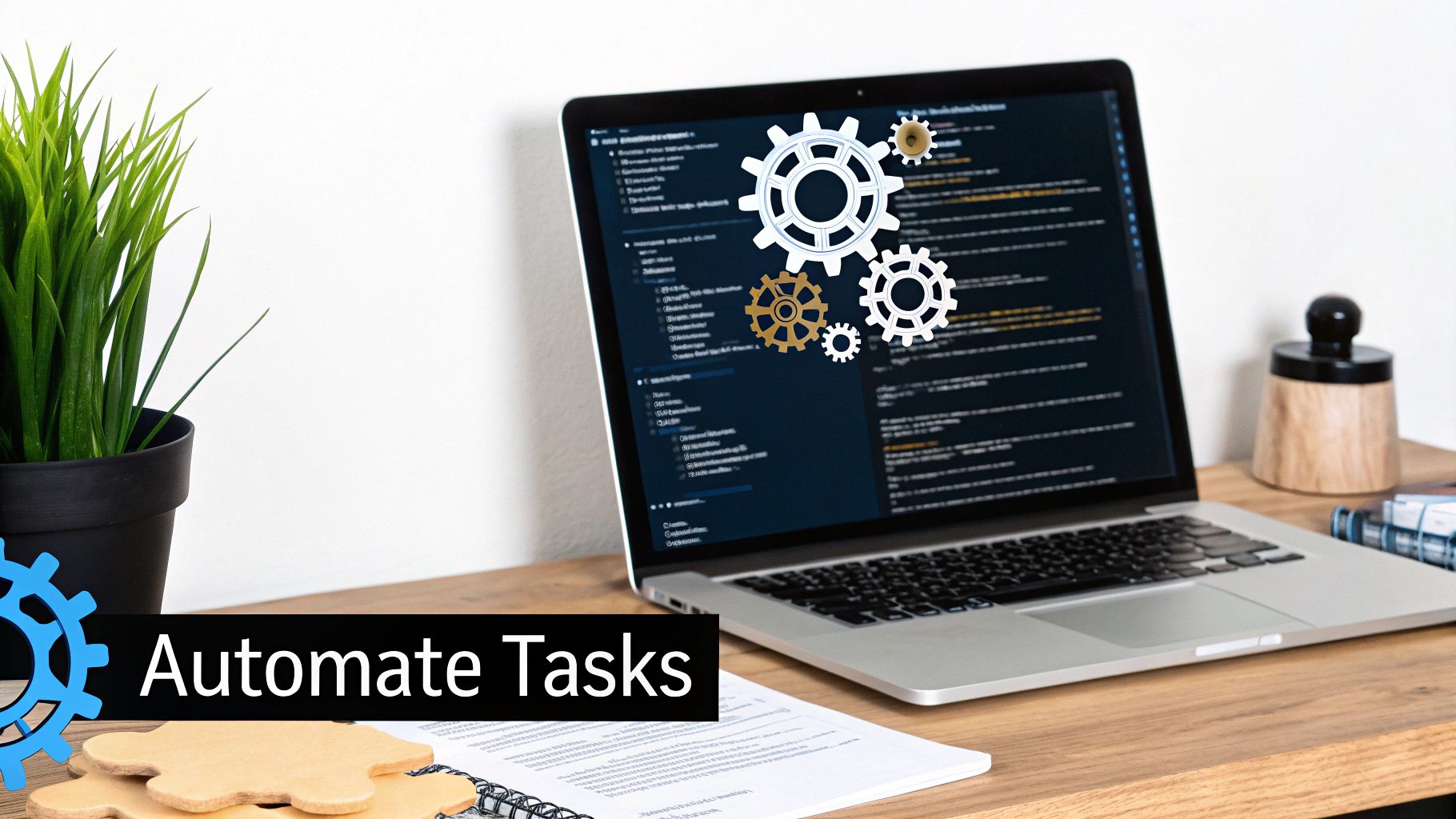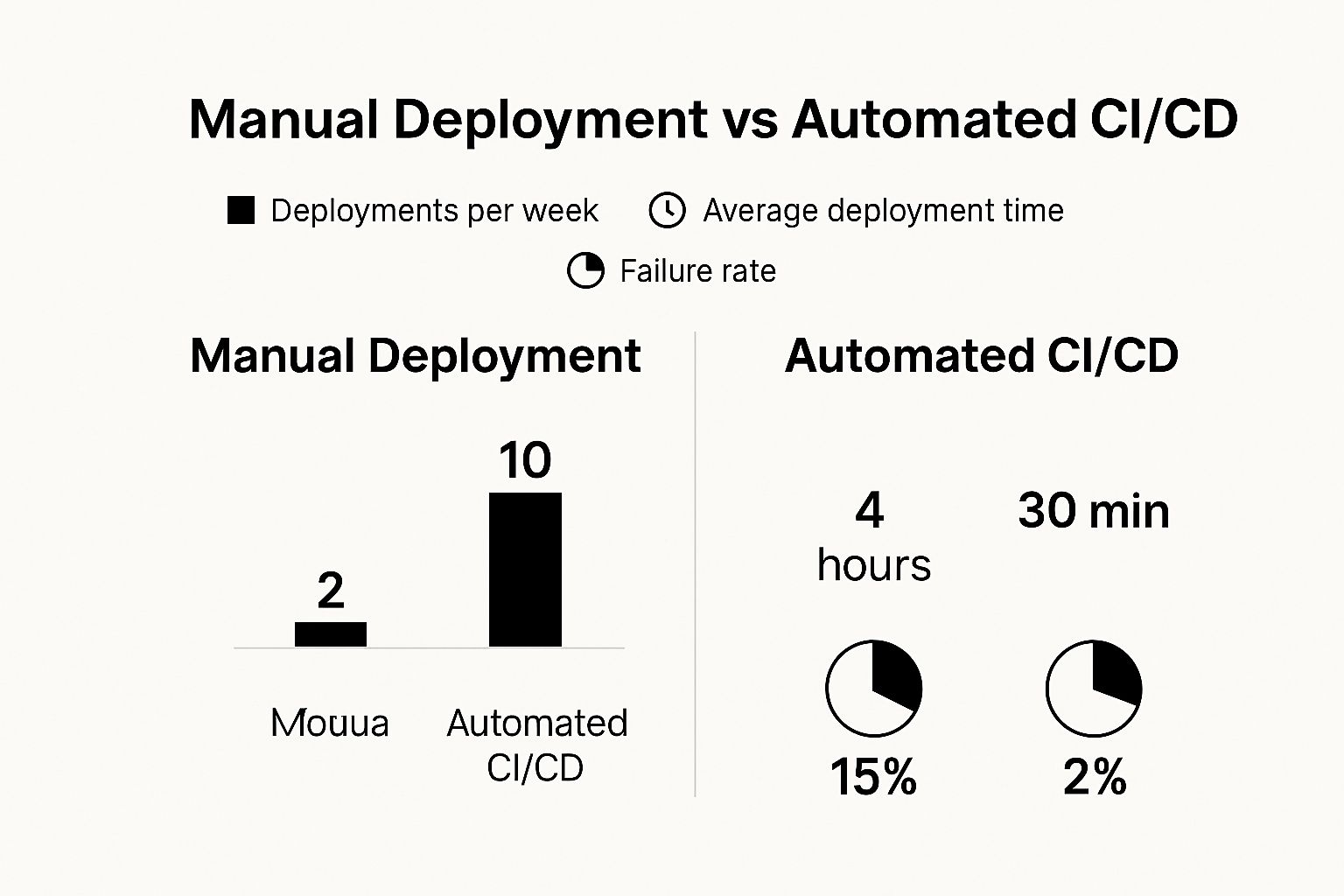Boost Your Team: Increase Developer Productivity Today
- Ron Smith

- Jul 27
- 14 min read
If you want to boost developer productivity, you first have to face a hard truth: your team is probably bleeding time and money in places you don't even see. I'm not talking about minor hiccups. I’m talking about the silent killers of progress—the repetitive tasks, the endless context switching, and the clunky onboarding that systematically destroy your timelines and budget.
The Hidden Costs of Inefficient Development

Lost productivity isn't about developers slacking off. It's about systemic friction. It's the daily grind of forcing your best people to spend their brainpower on low-value work. When a developer has to stop and hunt for documentation or wait around for a test environment to spin up, that isn't just a five-minute delay. It's a complete break in their mental flow, and getting back into that deep-work state can take ages.
This isn't a small problem. It's a massive, global issue. A recent industry survey dropped a bombshell: 58% of developers lose at least 5 hours every week to unproductive tasks. Many are losing between 5 and 15 hours. And while coding is what they do, the real productivity drains happen on the periphery—things like onboarding or wrestling with operational overhead. It’s no surprise that companies without modern tools like Internal Developer Portals see their teams waste even more time just trying to find what they need. You can dig into all the details in the 2024 developer productivity trends report.
Don't just think about this in hours. Think about it in missed opportunities. Five hours lost per developer, every single week. On a team of ten, that's 50 hours of innovation down the drain. Every. Single. Week. That’s a delayed feature launch, a competitor beating you to market, and a fatter operational bill.
To really get to the heart of what's dragging your team down, you need to look past the surface-level metrics. The problem is almost always buried in outdated processes and tools that haven't kept up with how software is actually built today.
I see these time-wasters pop up again and again in engineering orgs. They're often so ingrained in the culture that nobody even questions them anymore. To help you spot them, here's a breakdown of the usual suspects.
Common Developer Productivity Drains and Their Impact
Productivity Drain | Common Cause | Business Impact |
|---|---|---|
Repetitive Manual Tasks | No automation for environment setup, testing, or deployments. | Wasted engineering hours, increased risk of human error, slower release cycles. |
Constant Context Switching | Hopping between code, Slack, Jira, and infrastructure consoles. | Loss of deep work, developer burnout, fragmented focus, more mistakes. |
Complex Onboarding | Poorly documented, slow, and manual new-hire processes. | New hires are unproductive for weeks, senior developer time is wasted on hand-holding. |
Toolchain & Environment Hell | Inconsistent dev/test/prod environments; waiting for resources. | "Works on my machine" issues, long bug-fixing cycles, delayed feedback. |
Information Silos | Can't find documentation, API specs, or internal service owners. | Duplicated work, project delays, reliance on "tribal knowledge." |
These aren't just line items in a spreadsheet; they create a vicious cycle of inefficiency that hits your bottom line directly.
Fixing this isn't about telling people to "work harder." It demands a strategic shift. You need to invest in tools and processes that actually empower your developers instead of getting in their way. This is where a new kind of staff augmentation comes in. We offer a modern approach to workforce management, providing curated pods of global talent—Shorepod—that deliver high-performing teams at the most affordable cost, making them productive from day one.
Let's be honest: the old ways of building software are dead. The era of massive, multi-year projects with a launch date somewhere in the distant future is over. If you’re still working that way, you’re burning out your developers and bleeding cash.
The real key to unlocking developer productivity today is shifting to modern, iterative processes. It’s a strategic pivot from "big bang" releases to shipping smaller, more manageable increments of value, faster and more reliably.

This isn't just some new trend—it's about fundamentally reducing the cognitive load on your engineers. When developers are buried in enormous, complex codebases for months on end, the mental overhead becomes crushing. Breaking down those monoliths into smaller, self-contained chunks is how you minimize risk, build real momentum, and create a tight feedback loop.
The data doesn't lie. A historical look at software projects spanning four decades shows a clear move toward efficiency. Between the 1980s and the post-2000s, average project timelines dropped from a staggering 16 months down to just 7 months. At the same time, the amount of code shipped per project fell by roughly 60%, proving the industry has shifted to smaller, more focused work.
Stop Chasing Rigid Frameworks, Start Using Agile-Inspired Cycles
You don't need to become an Agile purist or adopt a rigid framework to get the benefits. The core idea is simple: break your work into short, predictable cycles—usually called sprints—that last one to four weeks. Each cycle needs a clear, achievable goal. That's it.
This approach creates a powerful rhythm for your team. It forces you to prioritize ruthlessly, clarifies what actually needs to get done, and gives you regular checkpoints to make sure work is on track. It also means you can finally adapt to changing requirements without derailing the entire project. For a deeper dive, check out our guide on agile software development best practices.
The magic here is turning an overwhelming mountain of work into a series of conquerable hills. Every completed cycle is a tangible win, and that's a massive motivator for any dev team.
Your Hiring Process Is Probably a Bottleneck—Fix It
Adopting modern processes also means you have to rethink how you build your teams. Let's face it: traditional hiring is slow, expensive, and creates a bottleneck before a single line of code gets written. This is where you need to get smart about how you bring in talent.
A new kind of staff augmentation is emerging, one that’s built for modern engineering teams and represents a significant advancement in workforce management. It’s not about finding individual contractors; it’s about accessing curated, pre-vetted pods of global talent at the most affordable cost. These are cohesive, high-performing units ready to plug directly into your workflow.
Here’s why it works:
Real Speed: You get to bypass those painfully long hiring and onboarding cycles. These teams are ready to start contributing from day one.
Cost-Effectiveness: You get access to world-class engineers at an affordable cost, letting you stretch your budget without sacrificing quality.
Laser Focus: Your core team can stay locked in on your most strategic initiatives while the pod takes ownership of specific projects or features.
This model is a perfect match for iterative development, giving you expert resources that scale on demand. It’s a modern solution for a modern workflow. For a broader look at streamlining your operations, these insights on how to improve business efficiency are spot on.
When you pair smarter processes with flexible, expert talent, you create an environment where developer productivity can finally take off.
How AI And Automation Can Actually Empower Your Developers

Let's be real. You can't have a serious conversation about boosting developer productivity without talking about emerging trends in technology like AI and automation. These aren't just trendy terms to throw around in meetings anymore; they are practical, field-tested tools that are fundamentally changing how engineering teams operate and how smart leaders manage their workforce.
The whole point is to get rid of the mind-numbing, repetitive tasks that drain your best engineers. When you free them from that manual grind, they can finally channel their brainpower into what you hired them for: solving tough problems and building things that matter. This is where AI-powered tools stop being a "nice-to-have" and become a critical asset for any team that wants to win.
Going From Mindless Repetition To Intelligent Workflows
A good starting point is applying the core ideas of Business Process Automation—tackling the obvious repetitive chores to streamline how work gets done. But the advancement of AI pushes this much further. It’s not just about doing tasks automatically; it’s about making those automated tasks smart.
Think about the AI code assistants you see everywhere now. Tools like GitHub Copilot or Amazon Q Developer are quickly becoming standard equipment for high-performing teams. They’re not just auto-completing code; they’re suggesting entire functions, generating boilerplate from a simple comment, and even helping draft unit tests on the fly. This slashes the time spent on the grunt work of coding, letting developers stay focused on the architectural and logical challenges.
Here’s the real secret: the biggest win from AI isn't just coding faster. It’s about reducing the mental friction that kills productivity. When an AI assistant can instantly scaffold a new component or pinpoint a subtle bug, it keeps your developer in a state of deep focus—that "flow state" where their best, most innovative work happens.
Automating The Entire Development Lifecycle
The real magic happens when automation goes beyond just the code editor. It’s about creating an intelligent, self-managing development pipeline that needs less and less human babysitting, speeding up the journey from a commit to a live deployment.
Here’s how this is playing out in the real world:
Smarter Automated Testing: AI-powered tools can now analyze code changes and generate relevant test cases automatically, sniffing out edge cases a human might overlook. This catches bugs earlier, improves code quality, and frees developers from the soul-crushing task of manual regression testing.
Intelligent CI/CD Pipelines: Modern CI/CD isn't just a simple script anymore. It can automatically build, test, and deploy code based on triggers like a new branch or a pull request. This means it can handle complex strategies like GitFlow without someone having to manually kick things off.
Infrastructure as Code (IaC) on Autopilot: Defining infrastructure in code was a massive leap. Now, tools are getting even smarter. Features like CDK Migrate can scan existing cloud resources and automatically generate the IaC templates to manage them, turning a painstaking manual audit into a single command.
This level of automation creates a tight, powerful feedback loop. Developers get faster signals on whether their code is solid, which builds momentum and confidence. It's clear that there are many interconnected **tips and strategies for improving developer productivity**, and AI is the thread that ties them all together.
When you embed AI and automation deep into your team's daily workflows, you aren't just handing them shiny new toys. You're fundamentally redesigning how they work. You're turning your development process into a finely tuned engine that actively supports productivity instead of getting in the way. For any company that wants to stay in the game, this is no longer optional.
Rethinking Team Structure with Curated Talent Pods
Let's be honest: traditional staff augmentation is a gamble. You spend weeks hunting for individual contractors, roll the dice on whether they'll fit your culture, and then watch your senior developers' time evaporate during a painful onboarding process. It’s an old, clunky model that creates drag before a single line of code is ever written.
But an emerging trend in workforce management and contingent labor flips this entire script. Instead of hiring lone wolves, smart companies are bringing in curated talent pods. Think of it as getting a pre-vetted, cohesive team of global engineers who already operate like a well-oiled machine, at the most affordable cost.
This isn’t about just filling seats. It's about strategically injecting a fully functional, expert team into your workflow. The focus shifts from hiring individuals to acquiring a complete, project-ready unit that integrates seamlessly and starts delivering value from day one. It’s a smarter way to access specialized, global talent without the brutal overhead.
Beyond Onboarding Toward Instant Impact
The biggest win here is killing the "integration tax." A curated pod sidesteps the painful learning curve and team-building delays that plague traditional staff augmentation.
The real cost of hiring isn't just the salary. It's the weeks—sometimes months—of lost productivity as new people get up to speed. A pod-based model compresses that timeline from months to days, giving you immediate momentum.
These aren't just random collections of engineers; they are cohesive units with established communication patterns and workflows. That pre-existing synergy means they can tackle complex projects with a level of coordination that would take an internally assembled team months to build. You can dive deeper into how to set up these modern teams by exploring our guide to modern agile team structure.
The difference is night and day. Just look at the impact of moving from a manual, friction-filled process to a streamlined one—a core benefit that high-functioning pods bring to the table.

The data doesn't lie. Adopting modern, efficient processes, like the ones already baked into a curated pod, directly translates to faster delivery and higher quality work.
To really drive this point home, let's compare the old way of doing things with the modern pod model.
Traditional vs. Curated Pod Staff Augmentation
Factor | Traditional Staff Augmentation | Curated Pod Augmentation (Shorepod Model) |
|---|---|---|
Time-to-Productivity | 4-8 weeks (individual sourcing, interviewing, onboarding) | 1-2 weeks (pre-vetted team, minimal ramp-up) |
Team Cohesion | Low; built from scratch, potential for friction | High; established workflows and communication patterns |
Management Overhead | High; requires significant senior dev and management time | Low; pod is self-managing with a dedicated team lead |
Skill Access | Limited to individual availability and skillsets | Access to a collective, multi-disciplinary skillset |
Cost-Effectiveness | High hidden costs (recruitment fees, lost productivity) | Transparent, affordable pricing with predictable, high-value output |
The table makes it clear: the pod model isn’t just a slight improvement—it fundamentally changes the economics and speed of augmenting your team.
Aligning Team Structure with Project Goals
This new way of thinking about contingent labor gives you the power to scale your capabilities exactly when you need them. It's a game-changer for any organization trying to increase developer productivity without locking into permanent headcount.
Tackle Ambitious Projects: Need to build a new product or a major feature? Instantly bring in a dedicated team without derailing your core team's roadmap.
Access Niche Expertise: Need specialized skills in AI, data engineering, or a specific framework? A curated pod gives you on-demand access to experts who are ready to go.
Manage Fluctuating Workloads: Scale your development capacity up or down as project demands change. You always have the right resources at the right time.
By rethinking how you build and augment your teams, you create a far more resilient and dynamic engineering organization. This isn't just staff augmentation; it's a modern strategy for getting the expert resources you need to innovate faster and more affordably.
Measuring What Matters for Sustainable Growth
So, you want to boost developer productivity. Great. But first, you have to answer the hardest question: how are you actually going to measure it?
If you’re still chasing vanity metrics like lines of code or tickets closed per week, you’re not just wasting time—you’re actively hurting your team. That approach rewards busywork, penalizes thoughtful engineering, and poisons the well with mistrust.
The real goal isn't about squeezing more out of individuals. It's about measuring what drives sustainable growth. This means you have to stop thinking about individual performance leaderboards and start looking at the health of your team and the efficiency of your processes. You use data to find bottlenecks, not to point fingers.
Beyond Lines of Code
Old-school metrics just don't cut it anymore. The smartest leaders I know are tapping into git-based data to get a real feel for team dynamics and workflow. One of the most telling metrics here is Diff Delta.
Instead of just counting lines of code, Diff Delta tracks the net change in your codebase—factoring in both added and removed code. It gives you a much clearer picture of the actual effort involved. Raw LOC could never do that.
We've seen analyses of thousands of repositories that show while no single git metric is a silver bullet, Diff Delta has the highest correlation with developer effort. For large repositories, it averages around 41%. That's a huge step up from flimsy metrics like commit counts.
It confirms what we already knew: one metric can't tell you everything. But Diff Delta gives you a strong, meaningful signal about what your team is actually doing.
The point here isn't to track developers like they're on an assembly line. It’s to use these signals to ask better questions. A low Diff Delta could mean a developer is blocked. Or, it could mean they’re deep in the weeds on a complex, critical refactoring project. Context is everything.
Combining Quantitative Data with Qualitative Feedback
The only way to get this right is by blending the hard data with human insights. That’s where a culture of real communication and clear goals becomes non-negotiable.
Metrics are meaningless unless they’re tied to clear objectives. To measure what actually matters, you need to define it first. Tools like OKR generator tools can be a good starting point for setting and tracking goals that push for genuine growth. This gets everyone on the same page about what "productive" even means for a specific sprint or project.
Here’s how you build a complete picture of your team's performance:
Meaningful 1-on-1s: Get past the status updates. Ask your developers what’s slowing them down. Are they stuck waiting on another team? Is the tooling a nightmare to work with? This is where you find the gold.
Honest Team Retrospectives: Use your agile retros to sniff out friction in the process. This is how you uncover the systemic issues that no metric will ever show you on its own.
Cycle Time Analysis: Track the time it takes from the first commit to final deployment. If your cycle time is consistently dragging, you have a clear sign of a bottleneck in your CI/CD pipeline, your review process, or your testing strategy.
At the end of the day, measuring productivity is about creating a feedback loop that actually helps people. It's about giving your team—whether they're in-house or one of our curated global pods—the information they need to fix their own processes.
When you focus on team-level metrics and foster real dialogue, you create an environment where genuine productivity can actually take root.
Got Questions? We’ve Got Answers.
When you're trying to make your engineering team faster and more effective, a lot of questions pop up. It’s natural. Here are a few we hear all the time from engineering leaders and HR managers who are tired of the old way of doing things.
"How Do We Even Start With AI Without Freaking Out The Team?"
Look, nobody likes a massive, top-down mandate. The "thou shalt use AI" approach is a guaranteed way to get eye-rolls and resistance.
The smart move is to start small and prove the value. An AI code assistant is the perfect trojan horse. It plugs right into a developer's IDE and delivers immediate, undeniable wins.
Once your team sees it firsthand—like watching it spit out boilerplate code or generate unit tests in seconds—the lightbulb goes on. You don't have to sell it anymore; they start pulling for it. The key is to frame AI as a smart assistant, not a replacement. It’s there to kill the boring, repetitive tasks so they can focus on the hard problems. That's not just a productivity hack; it's how modern teams get ahead by leveraging advancements in technology.
"How Do We Balance The Need For Speed With Not Shipping Garbage?"
This is the classic tug-of-war, but it’s based on a false premise. You don't have to choose between speed and quality.
True productivity isn't just about pushing code faster. It's about building the right thing correctly the first time and killing wasted cycles.
This is where you let the machines do the boring, repetitive work of quality control.
Automated Testing: This is your safety net. It makes sure that moving faster doesn't mean breaking more things.
CI/CD Pipelines: This standardizes your release process. It removes the "whoops, I forgot a step" human errors that cause production fires.
By automating your quality gates, you create a system where speed and quality actually help each other. It’s a core principle of any high-functioning software team: get the manual checks out of the way and build a reliable, automated system.
The real goal here is to create a "paved road" to production. When the path is smooth, automated, and secure, your developers can just focus on what they do best: shipping great features without getting bogged down by the process.
"Is A New Staff Augmentation Model Really That Big Of A Deal?"
Yes, absolutely. Because the way we build software has fundamentally changed, and workforce management must evolve with it.
The old model of hiring individual contractors is slow, clunky, and creates a massive management headache. It’s a system designed for an era that no longer exists.
The only model that makes sense today is Talent-as-a-Service (TaaS), built around curated, pre-formed teams—what we call "pods." This is the new kind of staff augmentation we offer: a cohesive, high-performing unit of global talent that plugs right into your workflow. It’s simply the most efficient and affordable way to get specialized skills on board without the friction of traditional recruiting. You get a massive boost to developer productivity from day one.
At Shorepod, we don't just talk about this new model—we deliver it. We give you access to curated pods of elite global talent at costs that make sense. Ready to build a faster, smarter team? Find out how at https://www.shorepod.com.
Comments